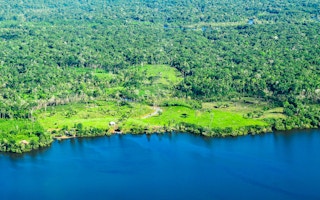Trees growing in floodplains surrounding the Amazon river emit up to 20 million tonnes of methane gas (CH4) to the atmosphere every year, a study in Nature has estimated.
Methane is one of the three most potent greenhouse gases and traps up to 34 times more heat compared with carbon dioxide.
The amount calculated in the study is similar to emissions from the Arctic tundra, or emissions from all oceans combined, or the total volume of methane emitted from wild animals and termites globally, the authors point out.
Still, the amount of methane emitted from Amazon trees is just half that emitted by humans, according to the authors — whether in the form of emissions from landfills, the meat industry, or burning fossil fuels.
The researchers argue that although they result from a natural process, these emissions may also be responding to environmental change, such as the building of dams across the Amazon basin. A separate study has reported that 140 hydroelectric dams are in operation or under construction along the Amazon basin, and another 288 are planned for the coming years.
“We do not know the consequences for emissions of such [construction] activity”, stresses Vincent Gauci, from the Open University and the study’s main author. “However, any changes to the dynamic hydrology of these systems could alter the function of these trees in unpredictable ways.”
Geographer Evlyn Moraes Novo, from Inpe’s Remote Sensing Division, says the findings are surprising and give a more complete picture of the sources of greenhouse gas emissions in the Amazon region.
“This could be used in global models designed to predict how environmental change can have a knock-on effect on the tropical wetland methane source,” says Evlyn, who was not involved in the study.
“
These trees act as chimneys, funnelling the methane produced in the submerged soil into the atmosphere.
Luciana Vanni Gattim, chemist, National Institute for Space Research’s Lab of Greenhouse Gases
The findings are based on measurements of methane emissions taken from 2,300 trees spread across a number of locations surrounding the rivers Negro, Solimões, Amazonas and Tapajós — where the water level can flood trees by up to 10 metres.
The research was carried out in 2013 and 2014 by scientists from the Open University in the UK, in collaboration with atmospheric scientists from the Nuclear and Energy Research Institute (Ipen) in Brazil, and other institutions including the universities of Leeds in the UK, Linköping in Sweden and British Columbia in Canada.
The researchers used gas chambers placed around tree trunks to estimate fluctuations in emissions at a small scale. They also measured methane with an aircraft flying across the entire Amazon basin in order to also calculate emissions at a large scale.
By analysing the measurements collectively, they found that trees growing in wetland areas of the Amazon subject to seasonal flooding emit 21.2 million tonnes of methane gas to the atmosphere every year.
“These trees act as chimneys, funnelling the methane produced in the submerged soil into the atmosphere,” chemist Luciana Vanni Gatti, from the National Institute for Space Research’s Laboratory of Greenhouse Gases (Inpe) and one of the study’s authors, tells SciDev.Net. “They are the source of the largest diffusive emissions ever recorded in wetlands.”
Biologist Luana Basso, from Paulista University in Brazil, who carried out the research whilst a doctoral student at Ipen, adds that “it is important to understand where this gas comes from in both natural ecosystems and from human activity”.










